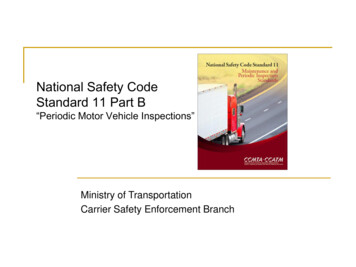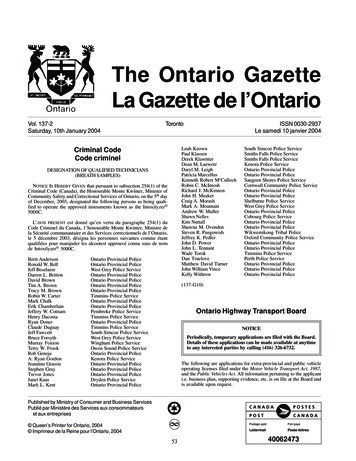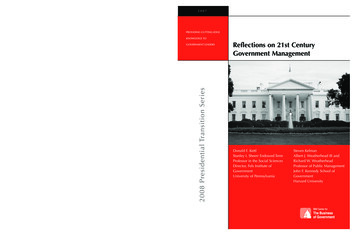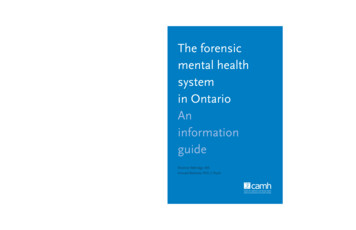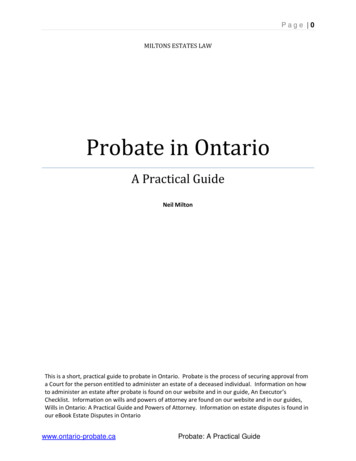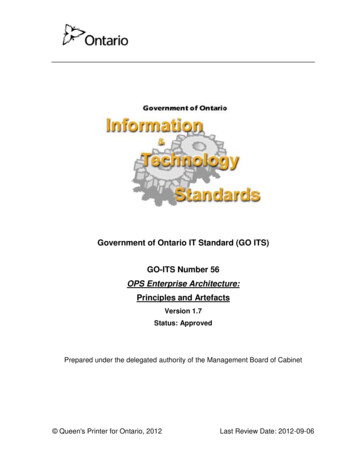
Transcription
Government of Ontario IT Standard (GO ITS)GO-ITS Number 56OPS Enterprise Architecture:Principles and ArtefactsVersion 1.7Status: ApprovedPrepared under the delegated authority of the Management Board of Cabinet Queen's Printer for Ontario, 2012Last Review Date: 2012-09-06
Sensitivity: UnclassifiedApprovedVersion #: 1.7Copyright & DisclaimerGovernment of Ontario reserves the right to make changes in the information containedin this publication without prior notice. The reader should in all cases consult theDocument History to determine whether any such changes have been made. 2012 Government of Ontario. All rights reserved.Other product or brand names are trademarks or registered trademarks of theirrespective holders. This document contains proprietary information of Government ofOntario, disclosure or reproduction is prohibited without the prior express writtenpermission from Government of Ontario.Template InfoTemplateNameTemplate#TemplateVersion No.GO ITSTemplate12.02.102.4Template AuthorDesign: PMCoEBoilerplate: SPPB/ICSTemplateCompletionDate2012-08-27Document HistorySummaryDate2009-06-17Created: GO-ITS 56 v1.0 - IT Standards Council endorsement2009-07-02Architecture Review Board approvalUpdated: Version number incremented to 1.4 to synchronize with theversioning of the Corporate EA Review Requirements The following changes to the appendices are based on updates tothe Corporate EA Review Requirements Guidebook approved bythe Architecture Core Team/Architecture Review Board during the2009 calendar year:o Appendix B Replaced version 1.3 of the Corporate EA ReviewRequirements Guidebook with version 1.4.o Appendix C Updated Section 2, Artefact/Template File CrossReference, with minor revisions to artefact and filenames.o Appendix D2009-12-11GO-ITS 56 OPS Enterprise ArchitecturePage 2 of 21
Sensitivity: UnclassifiedApprovedSummaryDate2010-04-16Version #: 1.7o Replaced templates with approved updated versions.Updated: The following changes to the appendices are based on updates tothe Corporate EA Review Requirements Guidebook approved bythe Architecture Core Team/Architecture Review Board during the2010 calendar year:o Appendix B Replaced version 1.4 of the Corporate EA ReviewRequirements Guidebook with version 1.5.o Appendix C Updated Section 2, Artefact/Template File CrossReference, with minor revisions to artefact and filenames.o Appendix D Replaced templates with approved updated versions.2011-06Updated: Replace all references to the Office of the Corporate ChiefTechnology Officer (OCCTO) and its intranet site with referencesto the I&IT Innovation, Controllership and Strategy Division (ICS). The following changes to the appendices are based on updates tothe Corporate EA Review Requirements Guidebook approved bythe Architecture Core Team/Architecture Review Board during the2011 1 calendar year:o Appendix B Replaced version 1.5 of the Corporate EA ReviewRequirements Guidebook with version 1.6.o Appendix C Updated Section 2, Artefact/Template File CrossReference, with minor revisions to artefact and filenames.o Appendix D Replaced templates with approved updated versions2012-06Updated: Improved instructions in the following templates:o Application-Inventory.doto Application-Usage-Pattern.doto Disaster-Recovery-View.doto Infrastructure-Usage-Pattern.doto Logical-Application-Deployment-Model.doto Logical-Application-Design-Document.doto Logical-Operating-Schedule-and-States.doto Physical-Application-Design-Document.doto Physical-Deployment-Model.doto Quality-Level-Metrics.doto SOA-Application-Service-Model.dotGO-ITS 56 OPS Enterprise ArchitecturePage 3 of 21
Sensitivity: UnclassifiedApprovedVersion #: ents.dot 2012-09-06Enhanced security requirements displayed in the followingexamples:o doco doco physical-deployment-model-example.docApproved: I&T Executive Leadership Council (ITELC)GO-ITS 56 OPS Enterprise ArchitecturePage 4 of 21
Sensitivity: UnclassifiedApprovedVersion #: 1.7Table of Contents1.2.FOREWORD . 6INTRODUCTION. 72.1. Background and Rationale .72.2. Target Audience.72.3. Scope .72.3.1.In Scope . 72.3.2.Out of Scope . 82.4. Applicability Statements .82.4.1.Organization . 82.5. Roles and Responsibilities.82.5.1.Contact Information . 83.TECHNICAL SPECIFICATION.103.1. Ontario Public Sector Enterprise Architecture Deliverables .103.1.1.Introduction . 103.1.2.Standard Set of EA Framework Artefacts . 123.1.3.Standard Specification of EA Framework Artefacts. 153.2. Further RELATED STANDARDS.17Impacts to Existing Standards .17Impacts to Existing Environment.17COMPLIANCE REQUIREMENTS.18Implementation and Metrics.18ACKNOWLEDGEMENTS.19RECOMMENDED VERSIONING AND/OR CHANGE MANAGEMENT.20Publication Details .20REQUIREMENTS LEVELS.21APPENDICES.22Normative References.22Informative References.22GO-ITS 56 OPS Enterprise ArchitecturePage 5 of 21
Sensitivity: UnclassifiedApprovedVersion #: 1.71. ForewordGovernment of Ontario Information Technology Standards (GO ITS) are the officialpublications on the IT standards adopted by the Ministry of Government Services for useacross the government’s IT infrastructure.These publications support the responsibilities of the Ministry of Government Services(MGS) for coordinating standardization of Information & Information Technology (I&IT) in theGovernment of Ontario.In particular, GO ITS describe where the application of a standard is mandatory and specifyany qualifications governing the implementation of standards.GO-ITS 56 OPS Enterprise ArchitecturePage 6 of 21
Sensitivity: UnclassifiedApprovedVersion #: 1.72. Introduction2.1. Background and RationaleThe I&IT Strategy, as approved by Cabinet in February 1998, initiated a project toestablish an OPS Enterprise Information and Information Technology Architecture (the“EIA Project”). This was to be a business driven, top-down, government-widearchitecture providing a framework and foundation for the information and informationtechnology strategy infrastructure projects, the major business initiatives and otherministry activities. It was also to serve as a management tool to coordinateinfrastructure initiatives across government and to gauge the impact of emergingtechnologies.The EIA project established an OPS Enterprise Architecture practice (EA practice), aswell as review and governance processes. The EA practice and processes haveevolved over time through very broad OPS consultation and senior managementapproval mechanisms (see Section 3, “Compliance Requirements” below for furtherinformation).As part of the EA practice, I&IT projects generate architectural work products called“artefacts”. Projects often use external consultants to create these. Also, vendors of ITproducts and services to the OPS will often need to understand requirements and facetsof OPS systems design as expressed in EA artefact format.Therefore, the purpose of this standard is to take key parts of existing authoritative OPSEA practice and encapsulate it in GO-ITS format in order to: Improve EA artefact visibility to external parties (as well as internally to theOPS); Enhance vendor understanding of, and compliance with, the OPS EA practice; Strengthen the management of EA artefact change by engaging the GO-ITSstandards process.2.2. Target AudienceApplies to all Government of Ontario ministries and advisory and adjudicative agenciessubjected to the Management and Use of Information & Information Technology (I&IT)Directive.2.3. Scope2.3.1. In ScopeOPS Enterprise Architecture:GO-ITS 56 OPS Enterprise ArchitecturePage 7 of 21
Sensitivity: Unclassified ApprovedVersion #: 1.7Deliverable definitions and templatesReview and governance processes for OPS Enterprise Architecture2.3.2. Out of ScopeDevelopment of solutionOperation of solution2.4. Applicability Statements2.4.1. OrganizationAll ministries, advisory and adjudicative agencies and clusters are subject to Government ofOntario IT Standards.All other agencies that are using OPS information and information technology products orservices are required to comply with Government of Ontario IT standards if they are subjectto either the Management and Use of I& IT Directive OR Government of Ontario ITStandards by Memorandum of Understanding.As new GO IT standards are approved, they are deemed mandatory on a go-forward basis(Go-forward basis means at the next available project development or procurementopportunity).When implementing or adopting any Government of Ontario IT standards or IT standardsupdates, ministries, I&IT Clusters and applicable agencies must follow their organization'spre-approved policies and practices for ensuring that adequate change control, changemanagement and risk mitigation mechanisms are in place and employed. For the purposesof this document, any reference to ministries or the Government includes applicableagencies.2.5. Roles and Responsibilities2.5.1. Contact InformationAccountable Role:Title: Assistant Head Architect, I&IT Controllership BranchMinistry/Cluster: Ministry of Government ServicesDivision: I&IT Innovation, Controllership and StrategyResponsible Organization:Ministry/Cluster: Ministry of Government ServicesDivision: I&IT Innovation, Controllership and StrategyBranch: I&IT ControllershipSupport Role (Editor):Ministry/Cluster: Ministry of Government ServicesGO-ITS 56 OPS Enterprise ArchitecturePage 8 of 21
Sensitivity: UnclassifiedApprovedVersion #: 1.7Division: I&IT Innovation, Controllership and StrategyBranch: Strategy, Policy and PlanningJob Title: Methodology SpecialistName: Dale HunterPhone: (416) 327-4858Email: Dale.Hunter@ontario.caGO-ITS 56 OPS Enterprise ArchitecturePage 9 of 21
Sensitivity: UnclassifiedApprovedVersion #: 1.73. Technical Specification3.1. Ontario Public Sector Enterprise Architecture Deliverables3.1.1. IntroductionThe architecture of an enterprise is the set of models that represent and describeit. Enterprise models serve as a basis for analysis; aiding managers determinethe changes needed to achieve government and ministry goals and objectives.They act as blueprints to guide and coordinate the efforts of those engaged inbuilding new enterprises or changing existing ones. In addition, enterprisemodels act as “standard interchangeable parts” as they are re-used within andacross enterprises, thereby contributing to the goals of integration and reducedsystems development time. Enterprise Architecture as a discipline consists of theprocess and methods used to develop and implement enterprise models.In large organizations, enterprise models are developed in different locations andby different teams, who, unless they work within a common framework, tend tocreate architecture products that may meet their own requirements but usuallycannot be applied elsewhere without a great deal of modification. Accordingly,when an organization wishes to standardize the work products of all its teamswho are engaged in any aspect of Enterprise Architecture, one of the firstmeasures that must be implemented is to establish a common EnterpriseArchitecture framework.The OPS has adopted the “Zachman Framework for Enterprise Architecture” , awidespread de facto standard, as the basis of a common Enterprise Architectureframework to be applied throughout the Ontario Government.The Zachman Framework is a structure for identifying, classifying and organizingthe descriptive representations (models) that are significant to the managementof an enterprise as well as to the development of the enterprise's systems.Alignment in the context of an enterprise is the state that is achieved when thephysical implementation of an enterprise – the funding, the staff, the systems, theinfrastructure, etc. – is entirely accounted for and aligned with the mission andgoals of the enterprise as expressed by senior management in strategic andbusiness plans. An aligned enterprise is one whose resources are all employedto achieve enterprise.To assist with such alignment, business and system projects follow an approachsuch that all levels of design, from conceptual to physical, are aligned with eachother when meeting a defined business requirement. This approach is the currentfocus of the OPS Enterprise Architecture Program.GO-ITS 56 OPS Enterprise ArchitecturePage 10 of 21
Sensitivity: UnclassifiedApprovedVersion #: 1.7Besides the normal documentation associated with project management, theseprojects produce specified mandatory and optional design artefacts (models).Alignment is confirmed by means of “checkpoint reviews” by an ArchitectureCore Team (ACT) and Architecture Review Board (ARB), often withrepresentation from various architectural domains.The purpose of the reviews is to ensure that the models align with the businessrequirement for the project and with each other, leading to the implementation ofa new or changed capability. In addition, the various models created by projectsare assessed for compliance with any applicable enterprise and domain-specificstandards.Checkpoint reviews occur at the following stages:Checkpoint 0: This is a planning, discovery, and guidance checkpoint toassist projects with understanding the Enterprise Architecturerequirements at the inception and concept stages of a project. With aclear understanding of the Enterprise Architecture requirements, projectmanagers can effectively plan the related activities and deliverablesnecessary to meet them.Checkpoint 1: Typically known as the “Business Architecture” of theproject. Deliverables for this checkpoint involve the Scope / Contextual /Planner and Owner / Conceptual deliverables that occur in Rows 1 and 2of the Zachman Enterprise Architecture Framework .Checkpoint 2: Typically known as the “Logical Architecture” of the project.Deliverables for this checkpoint are developed with a Systems / Logical /Designer perspective and are based on further elaborations of thedeliverables produced during Checkpoint 1 development phase.Checkpoint 3: The final “physical” description of the technologyimplementation of the project – presented from the Builder/Sub-Contractorperspective.Checkpoint 4: The purpose here is to: discuss the implementation of the project’s deliverables and anyarchitectural implications of which the architecture governancebodies need to be aware of; discuss lessons learned as part of quality improvement; provide feedback on architecture services.Variations on these checkpoints can occur depending on the nature of the projectand as determined by the Corporate Architecture Review Board.GO-ITS 56 OPS Enterprise ArchitecturePage 11 of 21
Sensitivity: UnclassifiedApprovedVersion #: 1.73.1.2. Standard Set of Enterprise Architecture Framework ArtefactsThe set of OPS EA Framework Artefacts shall consist of the following:Row 1ColumnArtefact TypeMandatory /OptionalM1Resource Type2Line of Business ProfileProgramServiceProgram ProfileOOOM3Location TypeGeographical Area TypeMO4Party TypeRole TypeTarget Group TypeMMM5Event TypeCycle TypeMO6GoalsNeedMandate (Program)Target Group/Need CrossReferenceMMMMGO-ITS 56 OPS Enterprise ArchitecturePage 12 of 21
Sensitivity: UnclassifiedApprovedVersion #: 1.7Row 2ColumnArtefact TypeMandatory/ OptionalMOOO1M21Conceptual Data ModelInformation ModelSemantic ModelFact and Dimension MatrixInterface Data RequirementsDocument2Service Life CycleBusiness Function ModelService Integration andAccountability ModelService ProfileBusiness Process ModelSOA Service SpecificationMMO33Business Network ModelM4Governance ModelOrganization ChartOO5State Transition DiagramBusiness ScenarioOM6Service ObjectivesBusiness Rule SourceBusiness Rule ProfileProgram Logic ModelMMMOOMM1This is a mandatory artefact for projects developing or acquiring data warehouse and/or data mart based solutions.Mandatory only for acquired solutions where there are application interface data requirements between the acquired solution andother business applications.3This is a mandatory artefact for projects following a service-based approach to assemble an application.2GO-ITS 56 OPS Enterprise ArchitecturePage 13 of 21
Sensitivity: UnclassifiedApprovedVersion #: 1.7Row 3ColumnArtefact TypeMandatory/ OptionalMO41Logical Data ModelLogical Dimensional Model2System FunctionalRequirementsMSystem Architecture DocumentLogical Application DesignDocument5OM63Solution Pattern MatchLogical ApplicationDeployment ModelMM6Supplementary SpecificationM4Mandatory artefact for projects developing or acquiring data warehouse and/or data mart based solutions.Projects following a service-based approach to assemble an application must also complete the SOA Application Service ModelTemplate.6For acquired solutions see the Corporate EA Review Requirements Guidebook.5GO-ITS 56 OPS Enterprise ArchitecturePage 14 of 21
Sensitivity: UnclassifiedApprovedVersion #: 1.7Row 4ColumnPhysical Data ModelMandatory/ OptionalMDatabase InventoryOPhysical Dimensional ModelO7Physical Application DesignDocumentApplication ImplementationDocumentApplication InventoryM83Physical Deployment ModelM4User Interface DesignO5Operating ScheduleM12Artefact TypeM9M3.1.3. Standard Specification of EA Framework DeliverablesArtefact descriptions provided in Appendix B, Corporate Enterprise ArchitectureReview Requirements Guidebook will often refer to one or more correspondingartefact template(s). When producing artefacts, business and system changeinitiatives must also use and complete any specified templates according to theinstructions in the artefact description and the template(s).When producing Enterprise Architecture artefacts, projects must follow theartefact specifications and templates as prescribed in the following documents(attached as Appendix C, and D respectively): Appendix B, Corporate Enterprise Architecture Review RequirementsGuidebookVersion 1.7Approval Date: September 6, 20127Mandatory artefact for projects developing or acquiring data warehouse and/or data mart based solutions.For acquired solutions see the Corporate EA Review Requirements Guidebook.9Optional artefact for projects implementing an acquired solution.8GO-ITS 56 OPS Enterprise ArchitecturePage 15 of 21
Sensitivity: UnclassifiedApprovedVersion #: 1.7Effective Date: October 1, 2012 Artefact Template Files3.2. Further ElaborationOPS architectural practice is further elaborated in the Enterprise ArchitectureProcess & Methods Handbook (as revised from time to time, with approval of thecorporate Enterprise Architecture governance process).4. Related Standards4.1. Impacts to Existing StandardsGO-IT StandardNoneImpactNot ApplicableRecommended ActionNot Applicable4.2. Impacts to Existing EnvironmentImpacted InfrastructureNoneImpactNot ApplicableRecommended ActionNot Applicable5. Compliance RequirementsThe Enterprise Architecture, I&IT Standards programs are based upon requirementsextracted from the following source documents: Management and Use of Information & Information Technology (I&IT) Directive(July 26, 2011)I&IT Deputy’s Committee Terms of Reference (May 2010)Policy Management Authority Terms of Reference (April 2010)I&IT Project Approval Committee Terms of Reference (January 2012)Operational Policy on the I&IT Project Gateway Process (January 26, 2007)These requirements provide the basic mandate, rationale, and conditions for the: Corporate Architecture Review Board;Corporate Architecture Core Team;Information Technology Executive Leadership Council ;GO-ITS 56 OPS Enterprise ArchitecturePage 16 of 21
Sensitivity: UnclassifiedApprovedVersion #: 1.7to define, provide, and authorize the methods, processes, and standards of the OPSEnterprise Architecture. This includes Enterprise Architecture review of projects and theartefacts that they are required to produce.5.1. Implementation and MetricsThe intention of the OCCIO is to advertise and promote this standard as being a mandatorycomponent throughout government. However, in order to effectively manage itsimplementation, ministries, clusters and applicable agencies are expected to adopt andmonitor compliance to this standard.6. AcknowledgementsConsultedOrganization Consulted(Ministry/Cluster)All ministries and clustersDivisionBranchDate1998 –ongoing(through EAgovernanceprocesses)Committee/Working Group ConsultedApplication Architecture Domain Working Group, Business ArchitectureDomain Working Group, Information Architecture Domain Working Group,Enterprise Architecture Methodology Working Group, Security ArchitectureWorking Group and Technology Architecture Domain Working GroupDate1998 –ongoing(through EAgovernanceprocesses)InformedOrganization Informed(Ministry/Cluster)Corporate ArchitectureCore TeamGO-ITS 56 OPS Enterprise ArchitectureDivisionBranchDate1998 –ongoing(through EAgovernanceprocesses)Page 17 of 21
Sensitivity: UnclassifiedApprovedVersion #: 1.77. Recommended Versioning and/or Change ManagementChanges (i.e. all revisions, updates, versioning) to the standard require authorization fromthe “responsible” organization(s).Once a determination has been made by the responsible organization to proceed withchanges, ICS as custodians of the I&IT Rules Refresh Plan will coordinate and provideassistance with respect to the approvals process.The approval process for changes to standards will be determined based on the degreeand impact of the change. The degree and impact of changes fall into one of twocategories:Minor updates - require confirmation from ARB, and communication to stakeholdersand ITELC. Changes are noted in the “Document History” section of the standard. Minorupdates generally consist of: Editorial corrections (spelling, grammar, references, etc.) made with the intentionto eliminate confusion and produce consistent, accurate, and complete work. Formatting changes (due to template updates or to improve readability ofdocument). Documented organizational changes e.g. renaming of committees, approvedtransition of committee responsibilities, approved reporting relationship changes.Standard revisions - require consultation with stakeholders, ARB endorsement, andITELC approval. Standard revisions consist of any updates to the I&IT Rules RefreshPlan that are not considered minor and may: represent new standard or significant revision to an existing standard represent a major version change to one or more specifications impact procurement require configuration changes to current solutions impact other standards respond to legislative, policy or procurement changes7.1. Publication DetailsAll approved Government of Ontario IT Standards (GO ITS) are published on the OCCIOIntranet web site. Please indicate with a checkmark below if this standard is also to bepublished on the public, GO ITS Internet Site.Standard to be published on both the OPS Intranet and the GO ITS Internet web site (available to the public, vendorsGO-ITS 56 OPS Enterprise ArchitecturePage 18 of 21
Sensitivity: UnclassifiedApprovedVersion #: 1.7etc.)GO-ITS 56 OPS Enterprise ArchitecturePage 19 of 21
Sensitivity: UnclassifiedApprovedVersion #: 1.78. Requirements LevelsWithin this document, certain wording conventions are followed. There are preciserequirements and obligations associated with the following terms:MustThis word, or the terms "REQUIRED" or "SHALL", means that the statementis an absolute requirement.This word, or the adjective "RECOMMENDED", means that there may existvalid reasons in particular circumstances to ignore the recommendation, butShouldthe full implications (e.g., business functionality, security, cost) must beunderstood and carefully weighed before choosing a different course.9. Appendices9.1. Normative ReferencesAppendix A – OPS Enterprise Architecture Principles Under separate coverContains architectural principles for each category.Appendix B - Corporate Enterprise Architecture Review Requirements Guidebook Under separate coverContains artefact descriptions and specifications.Appendix C – Corporate Enterprise Architecture Artefact Template Information Under separate coverContains artefact/template cross reference and instructions for accessing artefacttemplate files.Appendix D - Artefact Template Files Under separate coverConsists of a compressed collection of artefact template files.9.2. Informative References Management and Use of Information & Information Technology (I&IT) Directive:GO-ITS 56 OPS Enterprise ArchitecturePage 20 of 21
Sensitivity: UnclassifiedApprovedVersion #: (vwReadResourcesByRefId Content)/cpd2008.04.11.09.46.33.J6N res/ File/ManagementOfITDir.pdf Operational Policy on the I&IT Project Gateway .nsf/(vwReadResourcesByRefId Content)/cpd2008.08.18.15.46.12.R7F res/ ect%20Gateway%20Process.pdf Detailed documents and information (terms of reference, guidebooks, templates,checklists, mandatory/optional processes and deliverables, etc.) regarding theOPS Enterprise Architecture practice, review, and governance processes can befound occsIn particular, the Enterprise Architecture Process & Methods Handbook can befound occto/our-resources/eapmGO-ITS 56 OPS Enterprise ArchitecturePage 21 of 21
GO-ITS 56 OPS Enterprise Architecture Page 10 of 21 3. echnical Specification 3.1. Ontario Public Sector Enterprise Architecture Deliverables 3.1.1. Introduction The architecture of an enterprise is the set of models that represent and describe it. Enterprise models serve as a basis for analysis; aiding managers determine
